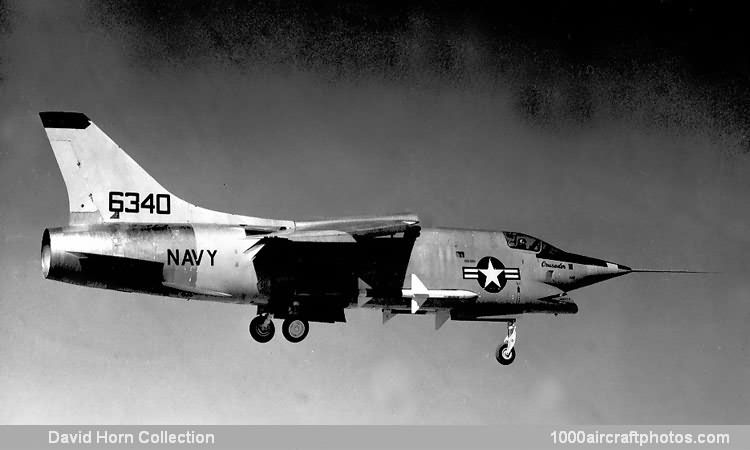Known to the manufacturer as the Crusader III, the FBU-3 retained some of the features of the original FBU, such as the variable wing incidence, but was a substantially larger, heavier and more powerful single-seat fighter. The FBU-3 was powered by a Pratt & Whitney J75-P-5A engine affording 16,500 lb (7,484 kg) st boosted to 29,500 lb (13,381 kg) st with afterburning. Provision was made for a 6,000 lb (2,722 kg) st Rocketdyne auxiliary rocket motor in the rear fuselage, and the all-missile armament consisted of three beam-riding Sparrow III AAMs (Air-to-Air Missiles).
The FBU-3 had a forward-raked, variable-position, chin-type air intake, and a pair of large ventral fins was linked to the landing gear retraction mechanism, being raised to the horizontal position when the wheels were extended and adopting a near-vertical attitude when the wheels were retracted. With selection of the F4H-l as the USN next generation shipboard fighter, the FBU-3 was cancelled, the three examples flown having accumulated a total of 190 flight tests.
The three prototypes were turned over to NASA, 146340, 146341, and 147085 became NASA "226", "227" and "225" respectively. NASA "226" and "227" were used for supersonic boom measurements at NASA Langley, Virginia, while NASA "225" was used at NASA Ames, California for flight systems and autopilot development. All three aircraft were scrapped in the early sixties."
Span: 39 ft 11 in (12,16 m)
Length: 58 ft 8 in (17,88 m)
Height: 16 ft 4 in (4,98 m)
Wing area: 450 sq.ft (41.80 sq.m)
Weight empty: 21,862 lb (9,917 kg)
Max T/O weight: 38,772 lb (17,587 kg)
Max speed: 800 mph (1,287 kmh) at sea level
1,457 mph (2,345 kmh) at 50,000 ft (15,240 m)
Cruise speed: 575 mph (925 kmh)
Stall speed: 154 mph (248 kmh)
Service ceiling: 60,000 ft (18,288 m)
Climb: 32,500 ft (9,906 m)/min
Range: 2,044 mls (3,289 km) (with max external fuel)
